Faugères and the area
The Village
Situated roughly half way between the Rhône and the Spanish border, about 15 miles north of Béziers and five miles south of Bédarieux, Faugères is on the south side of the first hills inland from the Mediterranean coast at an elevation high enough for refreshing summer breezes. Its 2,000-year history includes an important role France's 14th and 15th- century religious wars.
Nowadays, Faugères is best known for its wine appellation.
The village has a boules park and tennis court and a tourist information office situated at the windmills on the hill above the village.
Its sole retailer - Damejane - sells newspapers, bread, patisserie, wine and some deli items and is open from about 8am until 5pm during the week. A mobile butcher, greengrocer and egg seller visit the square next to the Mairie on Wednesday mornings.
Nearby Bédarieux is a busier market town, with a shops, supermarkets, banks, and restaurants, a weekly market and a railway station.
Béziers, the nearest large town, is some 25 minutes' drive away towards the coast.
Faugères village
Click on the pictures for larger images
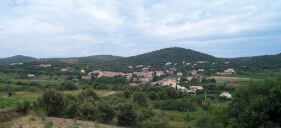
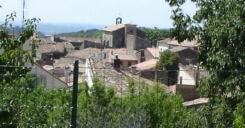
Faugères is famous for the three restored windmills that stand on the top of the hill above the village.
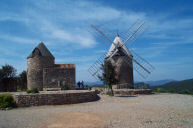
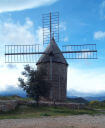
The Mairie is at the heart of the commune...
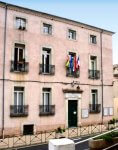
...while the village is rare in having two churches. The Protestant 'Temple' is about 200 metres to the west of the Catholic church.
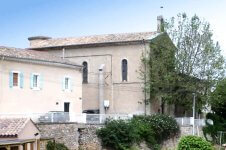
The 'bouledrome' is another village feature.
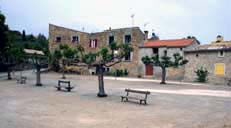
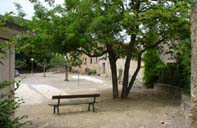
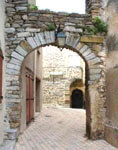
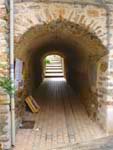


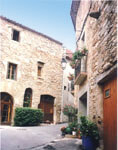
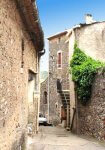
Faugères and wine
The dry, stony 'schiste' soil around Faugères means a monoculture of wine production. By 2017, the five villages in the appellation supported more than 50 producers, most welcoming visitors and selling their wines direct.
Faugères celebrates the Fête du Grand St Jean on the second Sunday of July each year.
The occasion attracts hundreds, with residents opening their cellars to wine and food producers for tastings as well as artists, craftsmen and women. The wine 'Confréries' parade in finery and often auction special vintages too.
Previous owners Michael Meadowcroft and Liz Bee have produced a guide - Faugères: a guide to the appellation - that is available as a free pdf download.
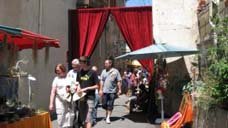
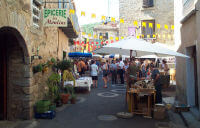
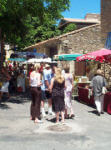

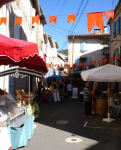
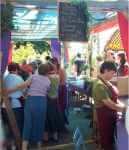
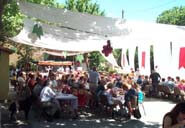

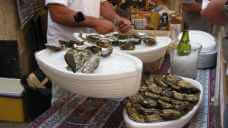
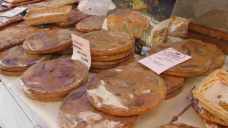
Wine producers at the Fête
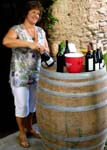
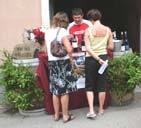

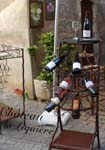
The area
The Languedoc includes much of France's Mediterranean coast. Many historical gems are within easy reach, ranging from the Roman remains in Nîmes to the Cathar castles and fortified Templar towns. Visits to all these are possible as day trips, as are the Pont du Gard and Perpignan.
The Mediterranean coast, with its sandy beaches, is about 25 miles away. The nearest - Valras Plage - is about 40 minutes' drive. (Béziers' commuter traffic can be slow!)
Montpellier and Narbonne are both less than 50 miles away, as are the mediæval towns and villages of Carcassonne, Minerve, Boussargues and La Couvertoirade, and the caves of La Clamouse and La Demoiselle.
The Orb and Mare river valleys, forested mountains, gorges and the inland lake of Salagou with its beaches and sailing are all not far away.
The active can canoe on the rivers, horse ride or walk. Routes include nearby treks through the vineywards and hills or further afield on the Grand Randonnees 7 (GR7 or E4) long distance footpath in the hills and mountains.
Birdwatchers are attracted to nature reserves along the spit of land between Agde and Sète.
One pleasure is never seeming to run out of things to do or places to visit within easy reach.
An eclectic list of what to 'see or do'
Whole day
- Carcassonne, Minerve
- Béziers, Ensérune (Roman remains), Narbonne
- La Couvertoirade, Cirque de Navacelles, St Guilhem le Desert
- Millau viaduct, Roquefort (as in cheese)
- Montpellier - busy city with wonderful open spaces, art gallery, Roman remains
Half day
- Béziers and Fontseranes - Cathedral, Allées Paul Riquet, Canal du Midi and its staircase locks
- Pézenas - town of Molière and old capital of the Languedoc, craft shops, Saturday market
- Agde - Old port town and new sailing/holiday resort
- Clermont l'Hérault - old town, castle ruin, Wednesday market
- Lodève - cathedral town, very good art gallery
- Cirque de Mourèze - dolomite rocks
- St Gervais and Mare valley
- Roquebrun - old village by the Orb and Mediterranean garden (very much uphill!)
- Olargues - historic town
Nearby towns and villages
- Boussagues - medieval fortified village
- Cabrières - copper mine, Roman and Neolithic remains
- Carlencas - good viewpoint with geological panoramas
- La Couvertoirade - templar village
- Dio - ruined castle
- Pézenas - historic market town (and Molière)
- Pézènes les Mines - old village and castle (not open)
- Villemagne - old abbey and walled village
- Hérépian - bell museum
- Bédarieux - local market town, museum and art gallery
Larger towns/cities
- Montpellier
- Narbonne
- Carcassonne
- Béziers
and further afield ...
- Perpignan
- Nîmes
Beaches/bathing:
- Barrages des Olivettes at Vailhan (very popular local bathing area)
- Lac du Salagou - inland lake
- Roquebrun - on the banks of the river Orb
- Valras, Vias, Serignan plages
- Naturist beach at St Pierre sur Mer (towards Gruissan)
Monuments:
- Pont du Gard
- Cathar castles
- Abbey of Valmagne
- Canal du Midi (and the rise of locks at Béziers)
Walks and trips into the hills:
- Gorges d'Héric/Caroux
- Monts des Espinouse, and further on - Monts de Lacaune
- Cirque de Mourèze
- Cirque de Navacelles
Railways:
- Petit Train Jaune (into the Pyrenees)
- Steam train from Anduze to Saint Jean du Gard
- Train touristique - Narbonne - Bize Minervois
Caves:
- La Clamouse
- La Demoiselle
Nature:
- African Reserve at Sigean - go very early to avoid the crowds
- Camargue
To find out more about the area try the following links:
faugeres.wordpress.com/
www.herault-tourisme.com
www.the-languedoc-page.com
www.languedoc-france.info/
www.bedarieux.fr
www.ot-montpellier.fr
www.gosouthfrance.com/Best-South-France-sites/canal-du-midi-tourism.html
www.guardian.co.uk/environment/2011/may/23/birdwatch-bustard-france-europe

